On the road once again, we left Bar Harbor and Mount Desert Island and pointed the car south on Route 1, the historic predecessor to Interstate 95.

It’s just two lanes in most places and winds its way through the many small towns and way-stations that grew up along it but no longer depend on it the way they once did.

The same story holds true for many of the small farms that don’t fit into the corporate scale of agribusiness as it’s currently practiced.

I hadn’t truly realized, before this trip, how much the Maine coast is fractured into long fingers that stick out into the Atlantic. Communities along this coast tended to form around the points where rivers flowed into the inlets between these fingers, places where flatter land and fresh water could be combined for agriculture, and where lumber and ship-building businesses could safely thrive. The major north-south roads and railroads stayed inside these inlets as well, as you can see on the map below where I marked our route in red.

Since each inlet was typically fed by a river or stream, keeping the road inland generally meant that it could cross the rivers with shorter bridges. In a few cases though, the rivers were large enough that real money had to be spent. One of these was at the Penobscot River, leading from the ocean to Bangor. An earlier bridge there has been replaced with a two-pylon cable-stayed bridge, for an elegant crossing.

We had to get a bit past the bridge to truly appreciate its delicate form. And from this viewpoint we could also see a bit downstream.

It’s tough country in which to be cutting stone and building roads and bridges.
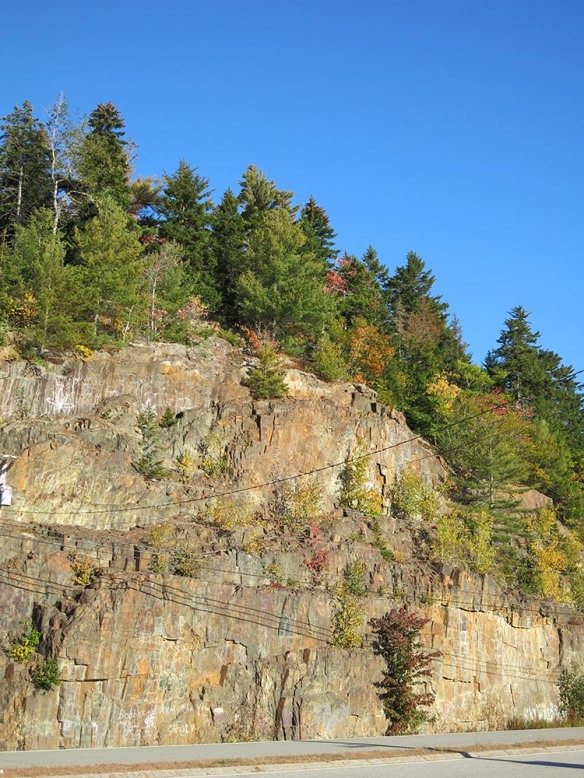
It took plenty of blasting to cut the nose off this mountain enough to fit the road in.
Shortly after this drama we arrived in Belfast where we were aiming for coffee breakfast at the Chase’s Daily restaurant which my brother had recommended.

Located at the mouth of the Passagassawakeag River estuary on Belfast Bay and Penobscot Bay, Belfast is the county seat of Waldo County. The seaport has a wealth of antique architecture in several historic districts.

Wikipedia photo
Getting to this point, though, has been a tumultuous process. The area was once territory of the Penobscot tribe of Abenaki Native Americans, which each summer visited the seashore to hunt for fish, shellfish and seafowl. In 1630, it became part of the Muscongus Patent, which granted rights for English trading posts with the Native Americans, especially for the lucrative fur trade. About 1720, General Samuel Waldo of Boston bought the Muscongus Patent, which had evolved into outright ownership of the land, and was thereafter known as the Waldo Patent. Waldo died in 1759, and his heirs would sell the plantation of Passagassawakeag (named after its river) to 35 Scots-Irish proprietors from Londonderry, New Hampshire. Renamed Belfast after Belfast, Northern Ireland, it was first settled in 1770, and incorporated as a town in 1773. The village was mostly abandoned during the Revolution while British forces occupied Bagaduce (now Castine). The British military burned Belfast in 1779, then held it for five days in September 1814 during the War of 1812.
Following the war, it developed into a shipbuilding center, producing hundreds of three, four and five-masted schooners. Materials for wooden boat construction were shipped down the Penobscot River from Bangor, the lumber capital of North America during the later 19th century. Wealth was invested in substantial buildings.

Wood ship construction petered out about 1900 but with the advent of refrigeration the economy shifted to harvesting seafood for east coast markets. After World War II, however, the Belfast economy was driven by its poultry industry, including 2 of the state’s larger processors, Maplewood and Penobscot Poultry. Waldo County farms supplied the factories with up to 200,000 birds a day. The annual Broiler Festival became a popular summer event, attracting both local people and tourists.
In true boom and bust fashion, the poultry business collapsed in the mid-1970s during a national recession, devastating the city and surrounding towns. In the early 1980s, the defunct chicken-feed silos at the foot of Main Street, that once fed millions of chickens, were demolished. There was an exodus of people seeking employment prospects elsewhere. In the early 1990s, credit-card giant MBNA established two facilities in Belfast, and Jobs provided by MBNA, which was recently acquired by the Bank of America, helped increase Belfast’s population significantly. Finally, in true circular fashion, in 1996, shipbuilding was re-established on the Belfast waterfront with the opening of French & Webb, Inc., classic wooden yacht builders and restorers. Following in their footsteps, Front Street Shipyard opened a major boatyard on the Belfast Bay in 2013. Together, the two boat-building companies have restored Belfast’s working waterfront and helped revive the city economy as well as appeal to tourists, like us.

Along with that sort of transition comes a certain amount of shopping-oriented things that, if you think about it, you don’t really need. But the presentation was hand-some.


It’s also a pleasant environment for just walking and sightseeing.

One consistent clue that reveals on-going gentrification is the addition of creative signage. I’m in favor of this graphic type of retail signage – it has a long historic lineage.
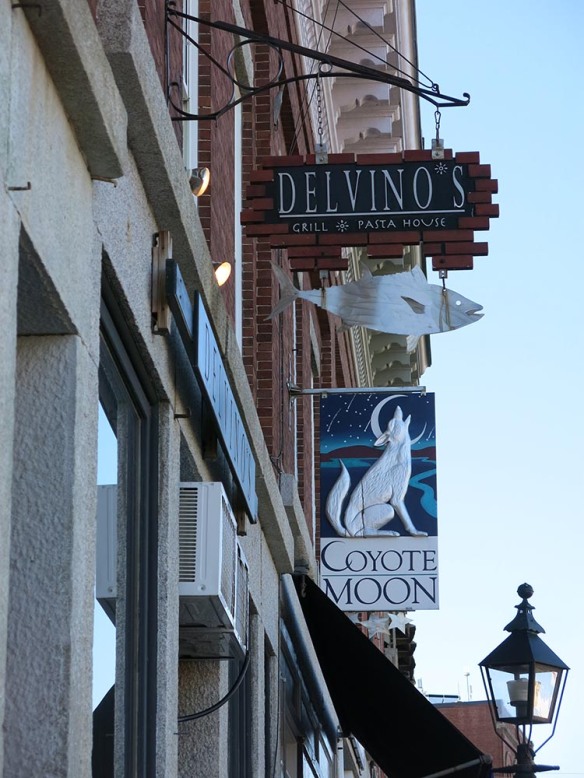
It did seem a bit odd to see a Cape Cod style house lifted atop a masonry base.

We were also glad to catch up with a bit of fall color.

It’s hard to tell without research what’s original below; but it looks as if third floors have been added to historic two-story buildings. They’re generally successful; but they show how much a seemingly minor detail like a balcony railing – on the left – can affect an historic roof line in an unfortunate way.

Here’s a real fall window box.

Our coffee stop was definitely a nice road-warrior break.
After another drive we stopped for a quick lunch break in Bath, Maine, county seat of Sagadahoc County and a real river-front town. Abenaki Indians called the area Sagadahoc, meaning “mouth of big river.” It was a reference to the Kennebec River.

I’m not sure what the road-planning choices were for this bridge and viaduct; but they blast a giant hole through the center of the community, not to mention the noise and pollution they leave behind. I suspect that it was simply a case of building the new bridge in the same place as the old one as the obvious solution. At least, along the riverfront below, there’s a pretty nice pedestrian park.
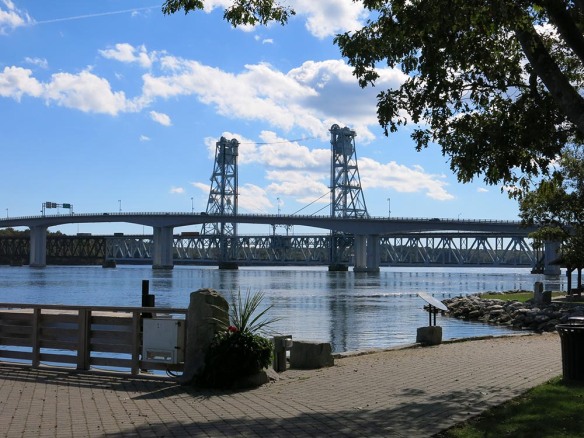
The city is home to the Bath Iron Works and Heritage Days Festival, held annually on the Fourth of July weekend. It is commonly known as “The City of Ships.”

Several industries developed in the city, including lumber, iron and brass, with trade in ice and coal. But Bath is renowned for shipbuilding, which began here in 1743 when Jonathan Philbrook and his sons built 2 vessels. Since then, roughly 5,000 vessels have been launched in the area, which at one time had more than 200 shipbuilding firms. Bath became the nation’s fifth largest seaport by the mid-19th century, producing clipper ships that sailed to ports around the world.
But the most famous shipyard is the Bath Iron Works, founded in 1884 by Thomas W. Hyde who also became the general manager of it in 1888. It has built hundreds of wooden and steel vessels, mostly warships for the U.S. Navy. During World War II, Bath Iron Works launched a new ship an average of every 17 days. The shipyard is a major regional employer and operates today as a division of the General Dynamics Corporation.
None of this really shows near the center of town where small pleasures suffice.

Past and present wealth and civic commitment have resulted in a well-built and generally well cared-for downtown – including the City Hall.

Bath City Hall
Our next stop was in Freeport – or rather at the real place everyone goes to in Freeport, the L. L. Bean outfitters store. L.L.Bean was founded in 1912 by its namesake, hunter and fisherman Leon Leonwood Bean.
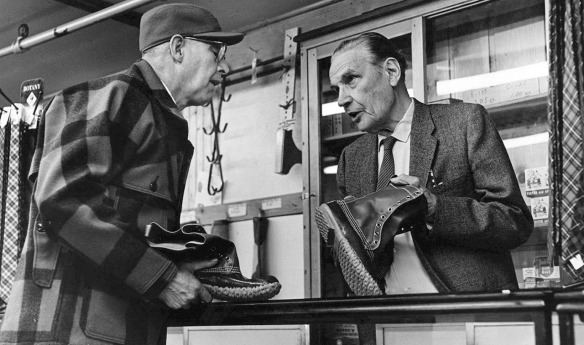
L. L. Bean convincing a customer
The company began as a one-room operation selling a single product, the Maine Hunting Shoe (also known as duck boots). Bean had developed a waterproof boot, which is a combination of lightweight leather uppers and rubber bottoms, that he sold to hunters. He obtained a list of nonresident Maine hunting license holders, prepared a descriptive mail order circular, set up a shop in his brother’s basement in Freeport and started a nationwide mail-order business. By 1912, he was selling the Bean Boot, or Maine Hunting Shoe, through a four-page mail-order catalog, and the boot remains a staple of the company’s outdoor image. Defects in the initial design led to 90 percent of the original production run being returned: Bean made good on his money-back guarantee, corrected the design, and continued selling them.
The current business is a long way from that basement beginning, comprising a multiple building campus with each building focused on different types of merchandise.

They haven’t forgotten their beginnings, though, and those duck boots create a popular focal point next to one of the entrances.

Selfie heaven !

The basic store seems like most suburban department stores, this department featuring their well-know canvas carry bags.

On the other hand, some of the details add uniqueness to the experience, celebrating both the wildlife (that you’re going to hunt) and letting you put your hands on both tools of the outdoors and crustaceans.

The connections between buildings softened the barn scale of the architecture with smaller scale elements such as porches.
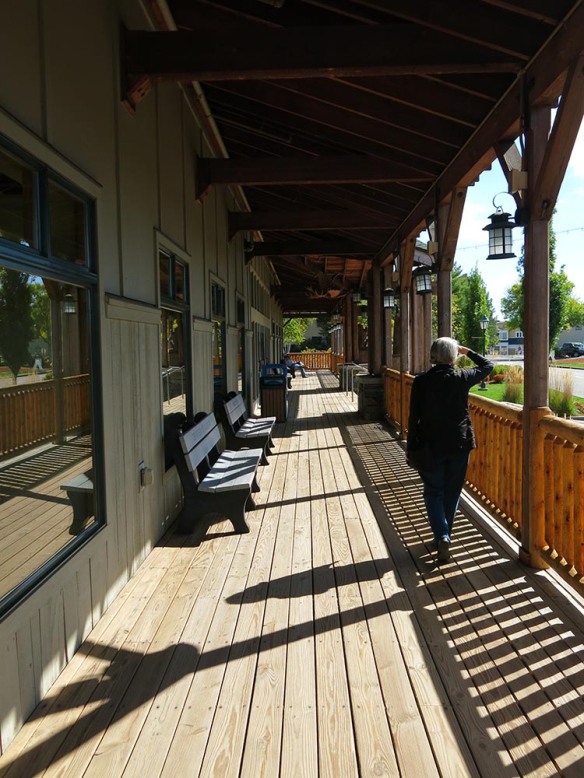
These elements were also used to create welcoming entrances – and at the same time keep snow from drifting up against the buildings in the winter.

In this case, the crustacean doors led to a home improvements store, where along with furniture and fittings, you could also buy bedding and map-of-Maine quilts.

After this respite we made one last, relatively short drive to Portland and the West End Inn where we would spend the night. More about that next time.


A most enjoyable tour, Mark. I was thinking that there must be a good supply of entrepreneurial spirit in Belfast for it to come out of so many downturns so well. Many places would have given up the struggle.
Hi Clare – Entrepreneurial that’s us. Or, we came, we saw, we extracted, we exhausted, we moved on to the next resource – that’s also us. The cod fishery that used to exist off the Grand Banks of Newfoundland is prime example number one. Gone, almost all gone.
Quite a tour, Mark – and I was going to say handsome towns, both Belfast and Bath. and now I’ve said it anyway. Quite a history to Belfast. And excellent photos, too!
Thanks. Not all iconic New England towns have such interesting histories. We were lucky to catch these two as stopping places.